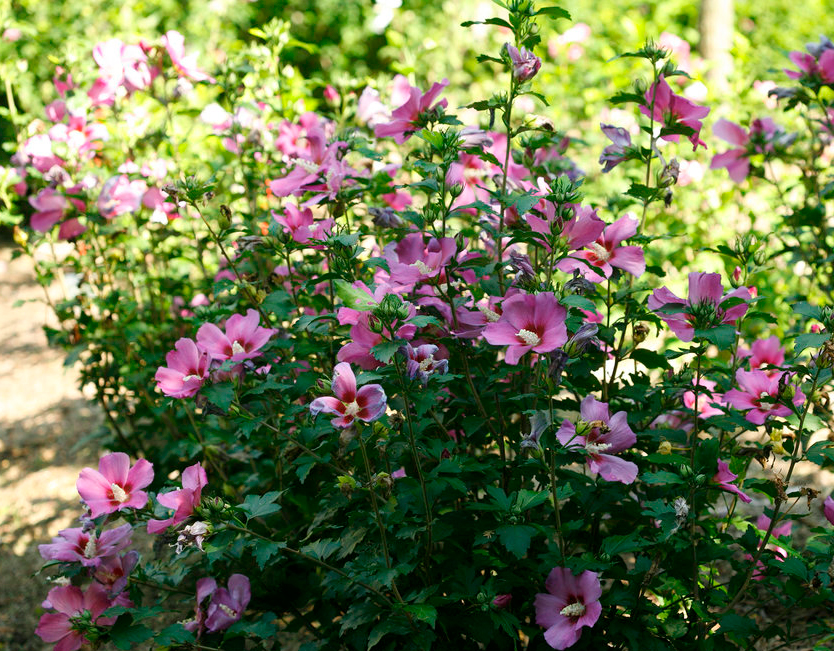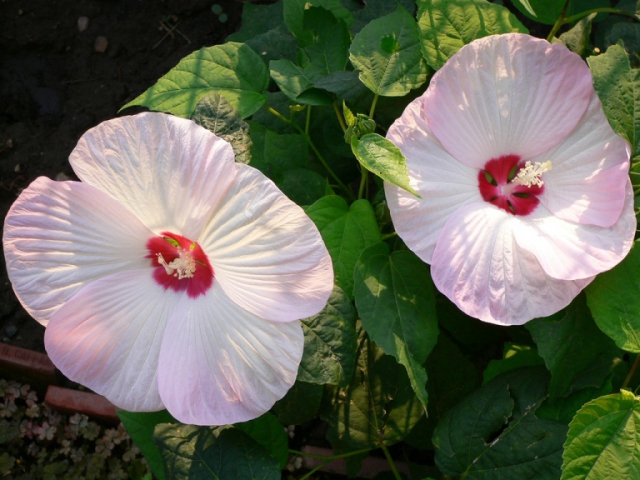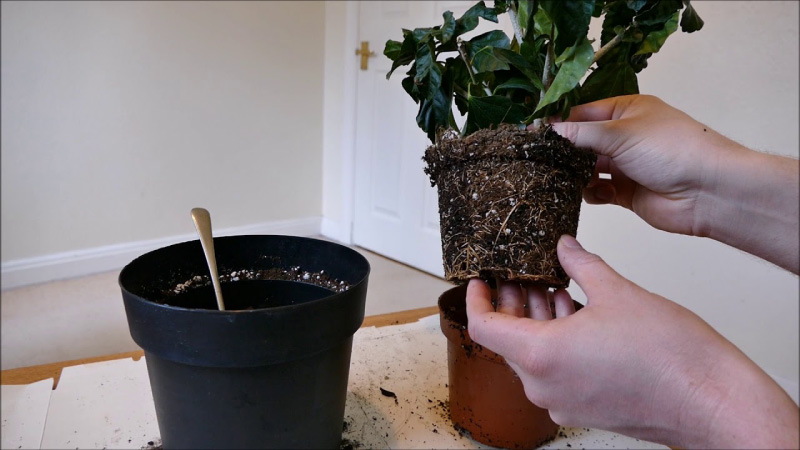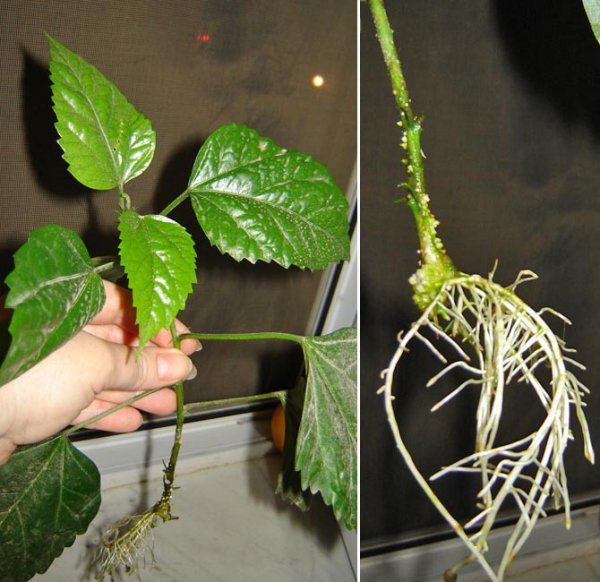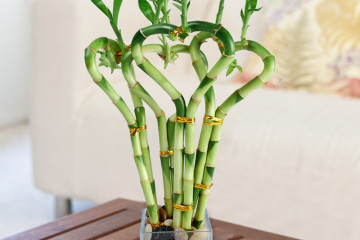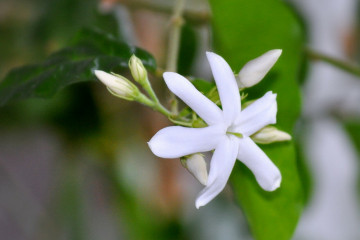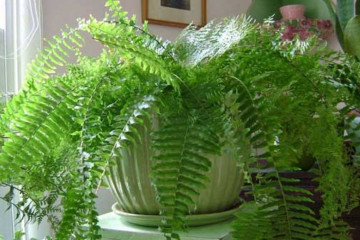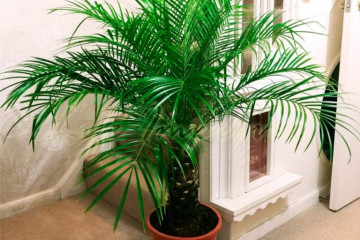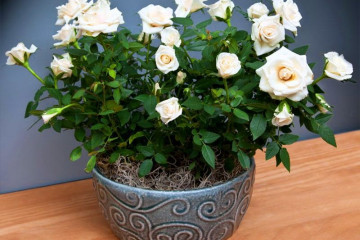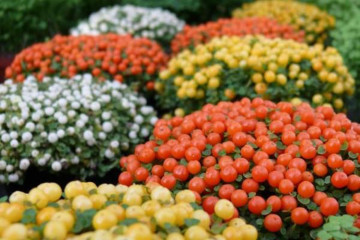Chinese rose or indoor hibiscus - home care
Content:
Not everyone knows what hibiscus is. This flower from the Malvov family has long been appreciated by flower growers as a beautiful and not too whimsical ornamental plant. Hibiscus is an indoor and garden flower, does not require any specific conditions for growing, any person can take care of it.
Origin and appearance
The birthplace of the flower is considered to be China, Southeast Asia and Polynesia. In natural conditions, the plant is an evergreen shrub or tree, reaching 5 meters. At home, Chinese hibiscus is grown - this is also a bush or tree, but it can grow in room conditions only up to 2-3 meters.
Its leaves are a bit like birch: they have denticles along the edge, a smooth sparkling corrugated surface of a dark green color, an elongated oval shape.
Single funnel-shaped inflorescences, at the time of full disclosure can reach 12-14 cm in diameter, in the middle there is a pistil, which may look like an elephant's trunk. Depending on the variety, there are different colors: white, yellow, red, pink and others.
Different plant names
Chinese rose, hibiscus, Chinese hibiscus - these are all names of the same plant. More than 250 varieties of this shrub are currently known. Some of them are intended for outdoor cultivation (in countries with the appropriate climate), others for indoor cultivation.
Is it possible to keep a Chinese rose at home
It is believed that hibiscus is the flower of death. This superstition is based on the fact that some plants rarely bloom, and a rapidly withering bud seems to bring death to the owner. In China, they try to get rid of the misfortune and burn faded inflorescences. Scientific research does not support these prejudices, so the flower can and should be grown at home. In many countries, other signs associated with the Chinese rose are known:
- Hibiscus is a flower of love and beauty.
- The presence of this plant in the house attracts the energy of love and tenderness, it is able to return old feelings to spouses with great family experience.
- The rapidly fading inflorescences absorb the diseases of the inhabitants of the house.
- Blooming hibiscus attracts grooms to their unmarried mistresses.
- The plant absorbs harmful substances and purifies the atmosphere at home.
- According to feng shui, the Chinese rose neutralizes black energy, protects households, and attracts goodness to the home.
- Parts of the plant have healing properties.
Types and varieties of Chinese rose
According to some reports, there are over 250 representatives of the hibiscus genus. Chinese roses can be:
- evergreen and deciduous;
- tree and shrub;
- perennial and annual herbal plants.
For example, the Syrian hibiscus, which is considered the ancestor, is an evergreen perennial that grows both as a tree and as a shrub. Syrian hibiscus Matilda, planting and caring for which in the open field is simple and not laborious, adorns many household plots.
Marsh hibiscus and hybrid hibiscus are herbaceous plants, in which the ground part dies off in autumn, and grows back in spring.
Marsh hibiscus
Distinctive qualities of this variety:
- well-developed root system,
- heart-shaped leaves,
- grows up to 3 m in favorable conditions,
- blooms from spring to autumn,
- red, purple or purple buds up to 15 cm in diameter,
- each flower lives only 1 day, leaving behind a box of seeds,
- unpretentious in care.
Terry hibiscus
It is known why terry hibiscus is so called: because of the spectacular multi-layered flower. A very popular variety both in Europe and in the Moscow region, it can be grown both indoors and outdoors.
A large number of breeding varieties are known that are distinguished by high decorative qualities (for example, lilac-crimson Ardens or Syrian chiffon, which blooms in white (White variety), lavender or pink flowers).
Hibiscus mutable
Variable hibiscus is prized for the fact that its flowers change pink as they bloom.
Cooper's hibiscus
Cooper's hibiscus (named after the grower who first grew such a variety in England) belongs to variegated varieties, differs from others in that the color of its leaves changes depending on the quality of lighting, soil composition and temperature conditions. Also pleasing to the eye with beautiful inflorescences.
Variegated hibiscus
Breeders have bred a large number of variegated varieties that differ from each other in the shape and color of both leaves and flowers. Some plants can simultaneously show foliage of different colors and shades: some leaves are green, others can be with red, white or yellow tints.
Hibiscus white
White hibiscus attracts with its tenderness and aesthetic appearance. There are many varieties, differing in appearance, preferred location and growing conditions.
Hibiscus red
Red hibiscus is the most common variety, easy to care for, can grow both at home and outdoors.
Hibiscus yellow
Yellow hibiscus is common in countries with cool climates (possibly due to the warm, sunny color). Many varieties have been bred, both simple to cultivate and delicate ones that require special care.
Hibiscus and hibiscus: what's the difference
Karkade red tea is made from hibiscus. But for these purposes, inflorescences of only one specific variety are suitable - the Sudanese rose. Flowers of plants of other varieties have some healing properties, but they do not have such a rich sweet-sour taste and red (or burgundy) color.
In addition, hibiscus is a plant, the word "karkade" is used to refer to a part of a flower and tea from it. The Sudanese rose is also called Roselle, Red Shavel, Sharon rose or Rosella, the scientific name is hibiscus sabdariffa. This variety is not suitable for home cultivation.
Transplanting a plant after buying into a pot
A plant purchased from a flower shop needs a transplant, since for transportation all plants are transplanted into a temporary pot and lightweight soil. After 10-12 days, when the plant adapts to new conditions, it must be transplanted into a new container.
What is needed for landing
For a transplant you need:
- A suitable pot, slightly larger than the one the plant is currently in. Ceramic is ideal.
- Transplant soil.You can buy ready-made or cook it yourself by mixing turf, leaf or pine soil with humus, sand, peat and a small amount of charcoal or vermiculite.
- Drainage (small pebbles, expanded clay or broken brick).
- Water.
Optimal location
The optimal place for placing a Chinese rose is warm (but not next to heating appliances), without drafts, with soft diffused light.
Step-by-step planting process
The best time to transplant is spring.
Landing order:
- A small layer of drainage is poured into the bottom of the new pot (the height of the layer depends on the size of the plant and the pot). Add a small layer of soil.
- Slightly moisturize the soil under the plant.
- The roots are carefully removed along with a clod of earth.
- If a transshipment is made, then the whole earthen lump is placed in a new container. When transplanting, the old soil is carefully shaken off, the root system is examined, damaged or diseased roots are removed, then the roots are placed in a pot.
- Fill up the free space with prepared soil, tamp the soil a little with your hands.
- Water the plant and return it to its usual place.
Reproduction of the Chinese rose
Chinese roses can propagate in two ways:
- cuttings,
- seeds.
Cuttings
Cutting order:
- cut off young branches (at least 4-5 leaves) and place them in water or wet sand;
- within 2-3 weeks, the cutting takes root;
- transplant the seedling into a permanent pot of a suitable size;
- planted in open ground no earlier than June.
Growing from seeds
Sowing sequence:
- The seeds are soaked in a growth stimulator for 12 hours.
- Sow in prepared soil.
- Cover the container with foil and place in a warm, dark place.
- The emerging seedlings are rearranged to a sunny place and grown to 3 permanent leaves.
- Seedlings are transplanted each separately.
Hibiscus care
Hibiscus is unpretentious, caring for it at home does not require special skills and abilities.
Watering mode
The Chinese rose does not store moisture for future use, so the plant is watered regularly. Abundant watering is carried out in the morning, but moisture is poured out of the pan, as it can lead to acidification of the soil.
Top dressing
For feeding, a universal complex fertilizer is used, in which there is enough nitrogen and calcium. Fertilizers are applied in liquid form.
During flowering
During the period of active growth and flowering, the flower is fed in small portions weekly. When applying fertilizers, it is important to remember that excess fertilization can be fatal to the plant.
During the rest period
During the dormant period (in autumn and winter), hibiscus is watered as the earth dries out, top dressing is applied in small portions and only once a month.
Hibiscus is a beautiful ornamental plant, well cultivated at home, which is easy to care for.
